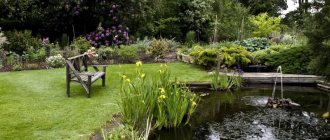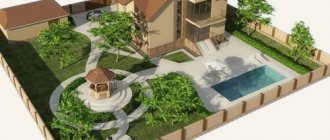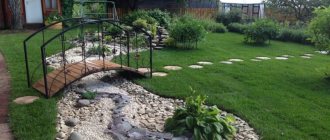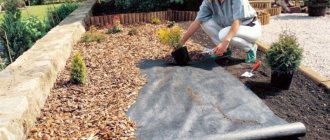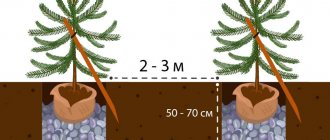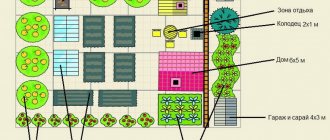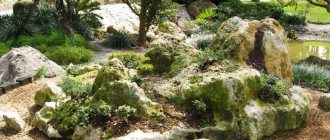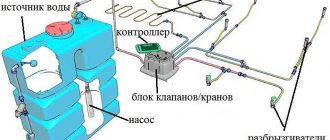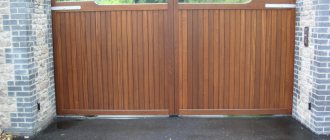Land development from scratch. Where to begin? on the Nedvio website
An irresistible desire “back to nature” has recently been characteristic of all residents of megacities.
And it doesn’t matter whether this will be a permanent place of residence in a comfortably equipped country house, or a nice summer cottage where the family goes on weekends - to relax or care for vegetable beds... We will not now consider the reasons for this phenomenon - this is a completely different topic, very large and serious. It’s worth thinking about this: if a plot of land is purchased that has already been inhabited, then no special problems arise with its arrangement. Unless, of course, you want to tear everything down and do it again. What if the plot of land is new, on which there is nothing but grass and weeds?
Proper site planning
An important stage when preparing a site for construction is zoning the territory. One of the zones is reserved for temporary waste and construction materials. It is also important where the equipment and special equipment will be located. For temporary accommodation of the construction team, cabins are installed. It is advisable to prepare the division of the area into zones in paper form, so that later controversial situations and inconveniences do not arise.
Completing all the activities listed above completely prepares the site for the construction of a future residential building.
Where to start landscaping an empty lot?
Typically, a site is divided into three main zones:
They, in turn, are divided into several subzones:
The arrangement of any plot must be carried out in accordance with this division and in advance. Otherwise, you may be faced with the fact that you want to add something, but there will be nowhere to put it.
The recreation area usually includes:
The economic zone includes:
If you plan to place a poultry house, then it also has a place in the economic zone.
Well, what to place in the gardening area is generally clear.
Leveling the ground for construction
Leveling the soil is an essential part of the work to prepare a site for construction. This stage can be accomplished using special equipment. Thanks to a bulldozer, you can cut off small mounds and level out depressions. Special equipment can be useful both on flat surfaces and in cases where there are various obstacles in the area. Such measures are required not only when building a house, but also when building a barn, bathhouse or any outbuildings.
If the landscape preparation is carried out in accordance with all norms and requirements, then in the future it will not be difficult to drain water from the installed foundation. Otherwise, if you locate a house or other building in a low-lying area, you may encounter various difficulties, such as flooding (in autumn and spring). This option will incur unplanned expenses. Building a foundation is not recommended in conditions of high humidity - this will lead to wear and destruction of the entire foundation of the house.

Planning the placement of buildings on the site
After we have decided what will be located in the local area, a detailed plan for landscaping the site and a diagram of the location of all buildings on it are drawn up.
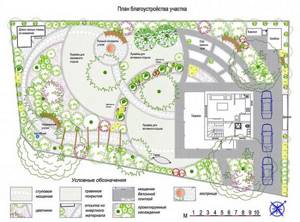
When drawing up a landscaping plan, it is worth keeping in mind such mandatory elements as: an access road, garden and paved paths, fences. When starting to develop the territory, it is necessary to determine exactly where and how all these elements will be located and draw up a detailed plan for their placement.
Deciding how we will use the site
Even before planning the territory, you need to decide exactly for what purpose and how the site will be used.
It is not at all necessary to place on the territory all the objects mentioned above. If, for example, you are interested in gardening, then it is quite natural to allocate a significant part of the entire territory for a garden. Gardeners will have the opportunity to create beds, but this must be done so that it is not too crowded. Again, do not forget about providing convenient access to the beds for processing them.
It’s a different matter if the dacha is used exclusively for recreation. In this case, it also makes sense to leave room for several beds (caring for plants within your means helps you take your mind off everyday activities and stressful situations), a couple of fruit trees and several gooseberry bushes (different options are possible).
However, the main attention should be devoted to infrastructure facilities, primarily for recreation. It can be:
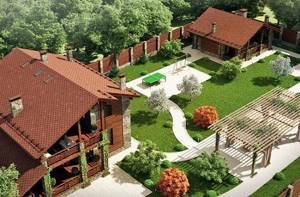
Those who are interested in landscape design can use at least the entire territory to create:
If desired, you can even design decorative colored lighting and use special architectural lamps.
In any case, you need to provide space for the house, garage and utility room.

Planning and zoning of the site
Only after you have decided on the features of using the local area can you begin to plan and zoning it.
Some owners simply skip this step, considering it unnecessary. This is also possible - if you do not have any special requirements. But planning, after carefully studying the characteristics of the territory, will greatly help to make the site not just unique - it will be ideal for permanent residence, recreation or doing what you love.
Source
Subtleties of planning the territory of an irregularly shaped site
It also happens that, due to the natural landscape or features of the general plan, the territory has an unusual shape. Some believe that planning a non-standard site, for example, a trapezoidal, rhombic or triangular shape, will not work. Due to sharp corners, it will be problematic to use the available space. The area on the slope is also unpopular.
One cannot but agree that creating a plan for such a site will require a lot of time and labor. The designer must be creative; it is possible that additional costs will arise. However, if a non-standard site plan is created by an experienced professional, the entire territory will be properly used. Costs will decrease, and all the disadvantages of the land plot will be turned into its advantages.
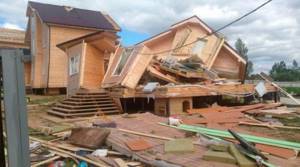
Geology of the site: objectives and stages of work Go
Which areas are considered non-standard:
- Territory on a slope
When the construction site is located on the slope of a ravine or next to a lake or river, the cottage should be placed taking into account the following features. If the slope is southern, the house needs to be located at the top, so it will be protected from landslides that occur due to melting snow and heavy rainfall. When the slope is eastern or western, the building should be located in the northern zone of the territory. North slope? Then we place the house at the western or eastern border of the site.
If the slope is steep enough, it should be divided into terraces. This work is quite expensive, but as a result you will be able to use the entire area of the site, and the slope will be strengthened.
- Narrow territory
Standard methods of planning a site, if it is narrow, will not work. The elongated area seems cluttered, objects are scattered chaotically and interfere with each other. To prevent this from happening, we make visual adjustments. On a narrow plot we place the cottage as close as possible to the end (short part). In the center you can equip outbuildings and plant tall trees.
Proper division of the territory into functional zones will allow you to divert attention from elongated forms. Even if it seems to you that the layout of the territory consists of zones changing each other, in reality, after you plant trees and add contrasting details, the site will seem more spacious.
- L-shaped section
If you have a construction site with this shape, you can get the most out of its arrangement. The L-shaped area is a regular rectangle to which another one has been added. It is best to create a relaxation area in this additional area.
- Triangle shaped area
Only a true professional can cope with the planning of such a site. At the same time, the future homeowner should also use all his imagination. There are no generally accepted rules on how to create a plan for a triangular territory; it is necessary to take into account the features of the site, the lengths of the sides and the sizes of the corners.
The main thing is that the cottage is located on the side opposite the sharp peak. To effectively use space, functional zones should be placed asymmetrically. Flower beds, gazebos, alpine slides, artificial ponds should be in the shape of a circle.
Where to start building a dacha? Step by step guide
People who bought a plot for the first time and are going to build a dacha for themselves most often do not really understand step by step what needs to be done, and are driven by the budget and the ability to buy something here and now for the dacha. In this article you will find step-by-step instructions on how to build a summer house and what you need for this.
1. To be on the site you will need a roof over your head. And most often everyone chooses a change house. We recommend buying a house made from pre-fabricated mini timber, which folds groove into groove, takes up less space than a change house, and its transportation can be much cheaper. For example, a house 2.5x2 meters in disassembled form, can be transferred on a trailer or on a gazelle. And if delivery of a cabin costs you 10,000 rubles, then delivery of a cabin in a smaller vehicle will cost a maximum of 3,000-5,000 rubles, or free of charge on your own trailer.
2. Septic tank. Yes, yes, we immediately recommend installing a septic tank and not making holes and a classic toilet. At a minimum, there will be no complaints against you from supervisory authorities in the future, and there will be fewer problems with its maintenance.
3. Well or well. Look at the situation here. You can hire a local crew for a well or watch videos on the Internet on how to make a well yourself, purchase everything you need, and do it yourself. We consider this method to be the most effective, since the quality of water improves and you spend virtually no money. You will still have the pump, and you can sell the drilling pipes, rent them out to neighbors, or offer them your well drilling services. This way you can still earn money.
4. In any summer garden house or shed, we recommend installing single-chamber, budget windows for the first time, but then immediately invest in protective roller shutters. They will allow you not to install an expensive and durable door, which is pointless in cabins, but at the same time, the little money that you spend on a simple door will be saved on more reliable roller shutters that will close both the door and windows. Roller shutters are three meters long and will cost you 15,000 rubles. And you will pay approximately the same amount for an iron door and its delivery.
5. Fence. At first, it is in your best interests not to make a high fence from corrugated board. Firstly, if you have a sparsely populated dacha area, it will definitely be removed. Secondly, it blocks the view on your site, and all sorts of dubious individuals can manage your site for a longer time, hidden behind the fence. We recommend installing a 1.5 meter chain-link fence for the first time. This way your entire site will be clearly visible and this is an additional guarantee that no one will want to operate near your house in front of everyone.
6. Trees. It’s in vain that everyone ignores planting fruit and ornamental trees in the first year. As a rule, this expense item is left for the last years of construction. And by that time, older trees are chosen, which are more expensive and more difficult to take root. It is better to immediately buy seedlings for 300-500 rubles and plant them in an overgrown area. Tall grass (weeds) will hide them from persons who want to dig them up. And by the time construction is completed, you will already have three-year-old trees that have already settled down and maybe even begun to bear fruit. But most importantly, mature trees have the opportunity to make a graft and definitely get a harvest for the next year. What is almost impossible to do on young seedlings of the same age, which also take root in the new land.
7. In the first year, when everyone comes to the still overgrown plot, most summer residents begin to plant potatoes, carrots, onions and cabbage. That is, the cheapest vegetables, which are always cheap in the store in any season compared to others. We recommend planting instead of these vegetables crops that are more resistant to wild conditions, which are more expensive in the store. Garlic, pumpkins, zucchini and eggplants, as well as tomatoes, are considered the best. Plant them first, and then pay attention to classic vegetables and herbs.
Source
Construction of a country house. Where to begin? From an idea and a project to a finished dacha on the Nedvio website
Times change, but country holidays in our country do not lose their relevance and attractiveness.
And there is nothing surprising about this. More and more residents of big cities are tired of the dynamic pace of life and want to escape into a world where they will be surrounded by silence, fresh air, and beautiful nature. That is why, recently, there has been such an active development of suburban areas in the Moscow region and other regions near large Russian cities, where people are building their country houses and houses.
If you are interested in having your own dacha and are interested in the question: Where to start building a dacha house? We recommend that you familiarize yourself with the recommendations outlined in this article.
Stage one: selection of area, number of storeys and material
The construction of any house usually begins with the acquisition of a plot. Although, even before purchasing land, it is advisable to already decide on the design of the house. Otherwise, it may happen that the chosen project will not fit into the size and landscape of the land plot, or it will be impossible to conveniently locate the house in relation to the supply of communications, etc.
After you have purchased a plot, you need to determine for yourself the desired type of construction. It could be:
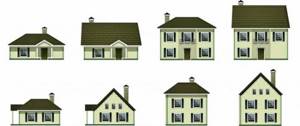
It can also be:
The materials from which country houses are built today are used in a wide variety. This:
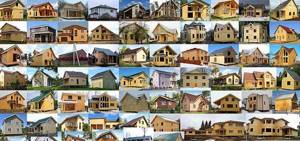
Today, country houses and garden houses are mainly built using frame-panel technology, but many other construction options are also used that do not require significant financial investments. Although in terms of choosing the material, of course, everything depends on your desire, budgetary capabilities and the functional purpose of the future home.
Basically, country houses provide for a seasonal period of residence. Country houses and garden houses are used, as a rule, from early spring until late autumn - with the onset of the first frost. Therefore, as a rule, low requirements are placed on their thermal protection and heating systems. The main thing is that the walls are strong and can protect the owners from precipitation, wind and other vagaries of bad weather.

Classic country houses have an area that rarely exceeds 50-70 square meters. m, and all their engineering and technical support mainly consists of a stove and fireplace. Although, if your village has central communications, it makes sense to use them and ask how much the connection costs.
Stages of landscape design
What stages does the landscape design of a summer cottage include?
Landscape design of a garden is a very comprehensive concept that includes not only an engineering aspect, but also a biological, historical and philosophical one. The main components of a landscape design project are simplicity and convenience, practicality and aesthetics.
A large number of owners of suburban areas often do not even imagine the complexity of the process of working on a landscape project. They consider it sufficient to simply buy trees, shrubs and flowers from the list and plant them where there is free space.
Based on such judgments, the prices for landscape services certainly become unclear. Let's look at what steps should be included in the design process, this will help to better understand the work of a landscape designer.
Stage 1. Request from the client for design
You can contact us by email or phone numbers listed in the “Contacts” section of our website. At this stage, our company’s specialists will tell you in detail about all stages of landscape design planning, the composition of the project, the cost of landscape design, agree on a date for visiting the site and answer all your questions.
Stage 2. Visit of a specialist to the site
Before starting the design process, it is necessary to collect information on factors characterizing the object:
- Topography;
- vegetation;
- the buildings;
- soil structure;
- location of windows and doors in buildings, etc.
Also take measurements of the site, determine shady, semi-shaded and sunny zones.
Based on the information received at the site, it is necessary to draw up a situational plan and conduct panoramic photography of the designed area from different angles.
At this stage, the budget and personal wishes of the Customer are also discussed.
Stage 3. Development of landscape design
This stage is one of the most exciting and creative in garden design. Two types of documents are drawn up here - a functional zoning plan and a conceptual plan.
Depending on the type and purpose of the site (for example, a cottage, a park, a school area, etc.), before creating the concept, it is necessary to decide on the zonal design, the location of the zone for secluded recreation, the fruit zone, the play area for children, the barbecue area, etc. .d. and discuss the creation of special conditions for animals, if necessary.
Stage 4. Landscape project modeling
Even with an excellent conceptual plan, the Customer will still not be able to fully imagine the idea of landscape design. In this case, it will be more important for our company’s specialists to produce a visual effect, which can be achieved through sketch or three-dimensional modeling of the landscape.
It is at this design stage that the Customer can see as close as possible the appearance of the future site.
Stage 5. Development of a site paving plan
Important aspects in the landscape design of a site include the design of a road and path network, which includes a paving plan and types of garden paving. After all, it is the paths and paved areas that determine the structure of the garden, creating a composition in it.
Stage 6. Preparation of the planning drawing
The measurements taken at the beginning of the design and the concept developed further make it possible to construct a layout drawing for the layout in the appropriate scale (usually a scale of 1:100 or 1:200) with the arrangement of all dimensions. The drawing reflects only the buildings and paving system.
Stage 7. Arboretum design
At this stage, the location of trees and shrubs is determined, at the same time a dendrological plan and an assortment list with a layout and planting drawing are drawn up.
The assortment list includes the entire list of plants, their quantity and main characteristics, which include height, crown diameter, type of root system, etc. The layout and planting drawing is drawn up in the appropriate scale with the arrangement of all sizes.
Separately, it is worth noting that projects of flower beds and decorative groups, with the participation of flowers in them, are placed on separate sheets and compiled at the request of the Customer - thus they are not part of the main project.
Stage 8. Landscape lighting design
The site lighting system not only has a practical function, ensuring safe movement around the garden at night, but also a decorative one, highlighting the necessary elements of landscape design, thereby emphasizing them. The choice of lighting fixtures depends not only on their appearance, but also on technical characteristics and efficiency. In order to harmoniously distribute light throughout the area, a special lighting plan is created, containing a list of lighting devices proposed by the designers in accordance with the landscape concept.
Stage 9. Selecting a site irrigation system
The choice of irrigation system directly depends on the wishes of the Customer and the capabilities of the garden plot, which include the presence of a water supply system or a well, etc. Another factor in choosing a given system is the types of plants that need watering. This stage involves developing a plan for the irrigation system, indicating the location of the sprinklers.
Stage 10. Drawing up a master plan
A master plan is a drawing that fully allows you to evaluate all the available space and implement approved design solutions on it.
At the final stage of landscape design, a master plan of the site is created, which contains all the information regarding the terrain features of the site, the systems available on it, as well as the places where trees, shrubs, flowers will be planted or small architectural forms will be installed.
The master plan of the site is the final version of the layout of the entire garden space, which is an integral part of any landscape design project. The master plan outlines the scope of work that will be carried out in the future on landscaping and landscaping the site.
Stage two: choosing a country house project
If the decision is made to build a country house, then the next step will be to work out its design component.
Initially, geological studies of the area should be carried out. This must be done to ensure that the selected land plot is suitable for carrying out all the necessary types of work. Based on the research carried out and the conclusion obtained, you can develop a project for a country house and plan where it will be built.
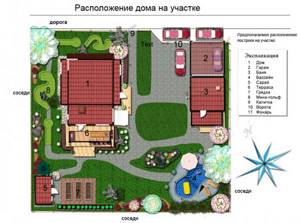
In the matter of design, in private housing construction, today there are several approaches:
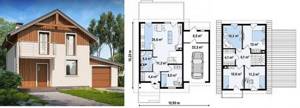
Keep in mind that your architectural preferences, in most cases, can be taken into account, but they may be limited by the characteristics of the land plot, its area, and terrain.
So, on a small plot (up to 5-6 acres), architects do not recommend building a large house (from 200-250 sq. m). The most natural ratio of the size of the plot to the area of the building is 1 to 10, and in the Moscow region - 1 to 5. Although, of course, this is not an immutable rule.
When choosing a dacha project, you need to think in advance about how many people will live in the house; the overall layout, number and area of rooms, and ceiling height depend on this.
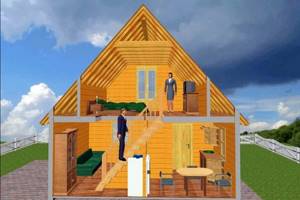
A competent and professional architect, as a rule, offers several design options or refines one to meet all your requirements.
Thanks to existing computer programs, today you can see in advance an image of your future home in three-dimensional format (3D) and study it in detail, which will undoubtedly help with choosing the appearance and design of your future dacha.
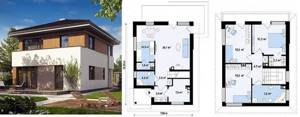
Next, calculations and development of design documentation are carried out. The working project usually consists of:
Architectural includes floor plans, roofing, facades. The structural one includes the foundation, floors, rafter structures and others. Drawings of water supply, heating, ventilation, sewerage, and electrical equipment systems constitute the engineering section of the project.
Attics. Types of mansard roofs. Which design is better to choose?
Which concrete is better to choose for building a country house?
Is it possible to build a house in 30 days and 1 million rubles?
Warm floor in a private house, cottage. Which type of heating is better: water, electric or infrared?
Concrete mixer for building a house. Which one is better to choose?
Plumbing of a private house: installation of pipes and checking their performance
Decorating the lawn with decorative and fruit trees
Buying a house with leased land. How is the right to a leased land plot registered?
Free connection of houses to gas. Will it or not?
Caring for your home in winter. What worries await the owner in winter?
Site Study - Evaluation Factors
Sometimes there is no harmony between various buildings and objects on a site. This is due to incorrect planning and ill-conceived design. You need to know the basic rules of composition and avoid the following mistakes:
- incomplete understanding of the purpose of the site, thoughtlessness of the general style;
- the desire to fill the territory with newfangled landscape design elements without prior planning;
- chaotic location of the house, buildings and structures, without maintaining the required distances;
- neglect of natural factors: terrain, groundwater level, wind rose, soil characteristics;
- planting green spaces without taking into account their further growth and activity.
To avoid mistakes, you need to think through everything to the smallest detail from the very beginning.
At the first stage, we study the site - we evaluate its shape and size, location relative to the cardinal directions, terrain, soil characteristics, groundwater level, climatic conditions. This will help to properly plan the site and place all objects taking into account their functional purpose.
The terrain can be either flat or hilly with elevation changes. If there are any terrain features on the site, we must take them into account and use them when planning. For example, if there are elevation changes, they can become the basis for creating an alpine slide or waterfall. The relief affects the placement of the house, buildings, and the laying of communications.
The size and shape of the site determine the style of its landscape design. The latter can be completely different - round, rectangular, strictly square or elongated. And it is very important that all buildings are located rationally, all corners of the site are effectively used.
Soil assessment is needed for further planting - it is important to understand what type of soil we are dealing with and what its acidity is. Depending on the characteristics of the soil and climatic conditions of the region, various green spaces are selected for cultivation and landscape design. You can obtain information about soil composition by submitting soil samples for analysis to a laboratory or by studying special geological maps. Depending on the results obtained, it may be necessary to cultivate the site: import peat, black soil or fertile soil, apply fertilizers in places where gardening work is planned.
An important factor when assessing land is the groundwater level, as it affects soil moisture. Depending on the depth at which groundwater lies, the following issues are resolved:
- whether to make water drainage, a drainage system;
- where is it better to build a house;
- what depth and where to drill a well or dig a well;
- what plants to choose and where to plant them.
To position the house as correctly as possible, you should take into account the wind rose and cardinal directions. It is important that each functional area receives sufficient sunlight. It is recommended to build a residential building on the north side of the plot so that the façade faces the south side and sunlight reaches the living rooms most of the day. The illumination of the area is taken into account when planting plants: some plants love shade, others need more sun.
Any area has its own climatic characteristics. When planning a site, you should take into account the wind rose of the given territory. It may be necessary to protect the area from the wind. This is important not only for the comfort of people, but also for growing plants. For example, windy weather is harmful to some plants. For heat-loving plants, appropriate conditions must be created, otherwise they will die.
One-story dacha project
If the task is to build an inexpensive dacha, developers prefer to build small one-story houses that fit well into any architecture or landscape and are quick to construct.
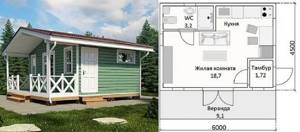
A one-story dacha is a building with one residential floor. Due to the simplicity of their design, one-story buildings are easy to repair, economical and convenient to use, and are ideal for country houses.
Projects for one-story houses make it possible to make the attic and basement functional, which can significantly increase the total area of the building. The advantage of this project is that one residential floor makes it possible to significantly reduce the load on the foundation and the costs of its manufacture. After all, the costs associated with the foundation in our climate make up a significant part of the development budget.
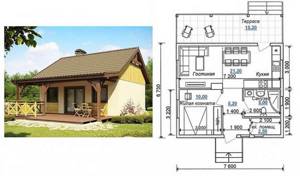
The construction of a one-story house is also advisable on narrow long plots and areas with subsiding, swampy, floating soils, or in the presence of karst sinkholes, since on such land it is impossible to build houses higher than one floor.
All rooms in 1-story buildings are located on the same level, therefore they are well interconnected and very convenient for elderly homeowners and people with diseases of the musculoskeletal system.
However, in one-story houses, it is not recommended to arrange many living rooms and utility rooms. Firstly, it increases the required area and length of the foundation. Secondly, the layout becomes more complicated due to the appearance of additional corridors to connect rooms.
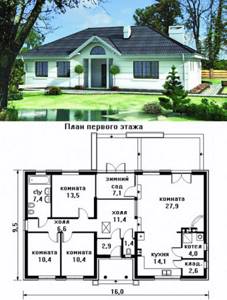
One-story dachas with stove heating are optimal if you plan to periodically live and relax on weekends in nature. Designing a one-story house is simplified by the absence of stairs, and this provides additional functional space.
Thus, when choosing a ready-made project or when drawing up an individual project for a 1-story dacha, you should definitely take into account: the nature of the soil, the depth and type of foundation, the location of the site, who will live and the seasonality of residence.
Tips for landscaping your backyard
The most successful shape option for a garden plot, in which the entire area is clearly visible and visually the plot appears larger, is a square. Therefore, the yard should be brought closer to this form. In order to visually increase the size of a rectangular plot, it is better to place the house on its short side.
When planning a site, you should consider the following expert advice:
- When placing the house, keep in mind that windows on the north side will quickly cool the house in winter, so it is better to place living rooms on the south side;
- outbuildings should not be placed inside the yard, assigning them noticeable places, they will not add beauty and will take up space, the best place for them is behind the house;
- For the vegetable garden and garden, it is also better to choose a place behind the house, having calculated in advance how much space needs to be left for planting trees, shrubs and plants;
- in a small area it is advisable to erect rectangular buildings, then you can rationally use the territory by placing more buildings;
- a country house is intended for rest and relaxation, so it is better to place decorative elements in the form of fountains, sculptures, small flower beds in the front and central parts of the yard;
- the playground should be clearly visible from the house and the recreation area, so it is often arranged in front of the house;
- so that trees with their branches do not interfere with walking along the paths, they need to be planted at a distance of at least a meter from the edge of the path;
- paths need to be laid not only to connect buildings and functional areas, but also for the convenience of working in the garden and walking around trees while walking in the garden;
- A hedge will be a beautiful decoration of the yard area; it will decorate the yard and protect from prying eyes; if you plant fruit-bearing bushes, you can reap a good harvest.
When planning a site, you should strive to ensure that all its elements look harmonious in the same style, visually expanding the territory. Zones should be located according to their functional purpose.
Two-story dacha project
When choosing the number of floors for a future dacha, it is sometimes better to choose a house with an attic or a two-story cottage. This will save on the area of the building spot on the site and make the foundation smaller.
Most often, two-story dachas are designed as follows:
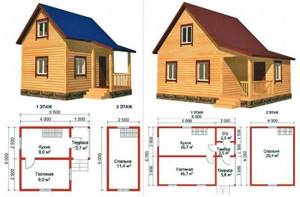
Projects of two-story houses suggest a wide variety of layout solutions, and the staircase to the second floor becomes the basis for an original design.
Two-story country houses usually have bathrooms on both floors. To save money and optimize the sewerage connection, it is necessary to arrange the kitchen and bathroom so that they have a common wall, and the upper bathroom is located directly above the kitchen or the lower bathroom along a common wall.
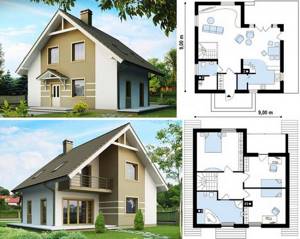
For newlyweds, when developing a project for their family nest, it is advisable to design one or better two additional rooms for future children.
The size of the house, the required number of rooms and premises, connection to communications - all this is important to take into account when developing the project, then later you will not need to rack your brains about how to expand or redesign the house.
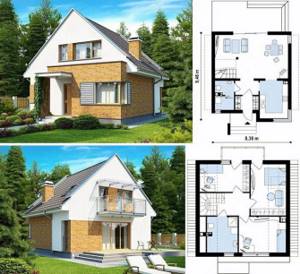
When choosing a ready-made project for a future dacha or developing an individual one, you should definitely take into account all the features of the land plot. A package of design documents will help you build a house without additional costs and unnecessary headaches, either with your own hands or with the involvement of a construction organization.
Stage three: Construction of a country house
Regardless of whether you prefer an individual project or a standard one, the construction of a country cottage will include the following stages.
(1) The first and very important stage is the construction of the foundation . The design features of the foundation can be different and depend on the soil, the depth of the aquifers, climatic operating conditions, as well as the total mass of the structure.
Given the small weight and area of dacha buildings, pile types of foundations are most often used for them.
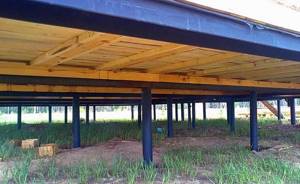
(2) The construction of the foundation is followed by the construction of walls. As already mentioned, the materials for them can be: timber, brick, wall blocks, logs and others.
(3) Next, the roof is mounted, doors and windows are installed, and the floor is laid. The necessary finishing work is being carried out.
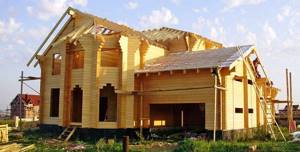
(4) The final stage is the installation of utilities - water supply, gas, electricity.
Taking into account all the technological features of construction, you need to budget from several months to 1-2 years to build your house. If you are not satisfied with this scenario and you want to become the owner of a summer house faster, and also expect only seasonal use in it, there is another option - to purchase a set of a ready-made house.
Prefabricated country houses
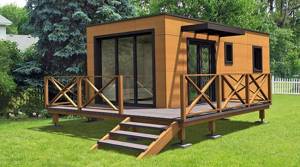
Such objects are delivered to the site in a semi-assembled form, from modules and parts already built at the manufacturer. Such buildings are perfect for summer living, simple in design and easy to assemble.
Another advantage of ready-made garden houses is that they can easily be placed on any, even the smallest, plot. At the same time, they can be erected in just a few days - the parts of the future house are brought to the construction site disassembled and assembled on the site according to the scheme, like a construction set.
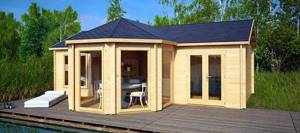
Such a country house has a neat and attractive appearance, while being reliable and easy to use, you can live in it right away.
Stage four: Landscaping
After your country house is built, you can begin to improve the surrounding area.
Here you can realize all your design fantasies and create the site of your dreams: an English lawn or an alpine slide, a pond or a fountain, or maybe a garden or a small grove? Any of your fantasies will find their fulfillment.
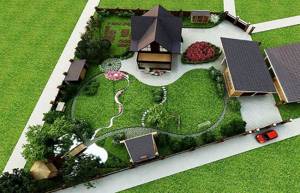
The final touch in the design of a summer cottage will be the installation of furniture, gazebos, swings, hammocks, and children's playgrounds. Now you have everything for a wonderful, complete rest.
Recommendations for placement of main objects
The composition of buildings on a summer cottage and their placement depends on their future use: for all-season living or for the summer period. If you plan to build a house, then it should be located so that the windows of the bedrooms and living room face the south or southeast. It is better to make the door on the leeward side. According to sanitary standards, the distance from the house to the roadway should not be less than three meters, and to the highway - at least five meters.
There must be a distance of at least three meters from the property line from the house, and protruding parts should not extend into the territory of the neighboring plot. There should be a distance of at least 8 meters to the sauna or bathhouse, and 12 meters to the toilet. Outbuildings take up a lot of space, so it is better to place them behind the house.
Having drawn them on the building plan, they need to be connected with the shortest lines that will represent paths. In landscape design, paths can be winding. It is advisable to make the width of the main path about two meters so that two adults can walk along it side by side. It is more convenient to make auxiliary paths 1 meter wide.
To locate all of the above zones on a site, its area must be at least 10–15 acres. It is better to arrange a vegetable garden and a garden on the south side of the site, in places where the groundwater is deep enough so that the soil is not waterlogged, or you will have to make a drainage system to remove excess moisture.
Trees should not be planted next to buildings, as the root system can damage the foundation over time. When choosing seedlings, you should check with the seller about the activity and parameters of an adult tree in order to correctly plan the planting site.
Lawns and flower beds are located around the house, in front of the main entrance, in the recreation area. To make it easier to care for flower beds, it is better to make them small. In places where there is a lot of shade and the plants will not receive enough sunlight and heat, it is better to arrange a rockery or alpine slide.
For a sports field, a flat area, shaded by trees, but sheltered from drafts, is suitable. It is better to arrange the pool in an open area away from trees so that leaves do not clog the water. You can make several recreation areas, if the total area allows, and place them in different places, this will give you the opportunity to retire for relaxation.
